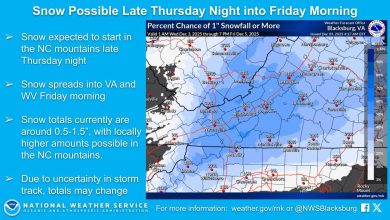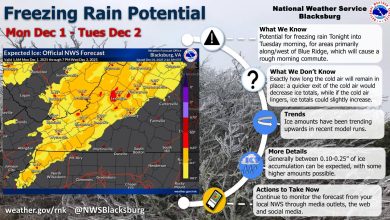Last Updated on January 24, 2013 12:07 pm
With winter weather predicted to hit parts of the state on Friday, N.C. Department of Transportation crews in many regions are pretreating roads and taking other steps to prepare for the storm.
NCDOT maintenance crews are using a salt-water mixture called brine, which is a cost-effective way to help prevent snow and ice from bonding to the pavement.
Statewide, more than 1,900 trucks are equipped with snow plows and graders in addition to 325 front-end loaders and backhoes and 450 motor graders. NCDOT has 146,500 tons of salt on hand. A typical statewide frozen precipitation event requires 40,000 tons of salt.
Here’s what crews are doing across the state to prepare for the storm:
North Carolina Mountains and Foothills:
Crews are treating major roadways across the mountains and foothills with brine. Once that is completed, equipment will be refitted with plows and spreaders and be on standby until needed.
Greater Charlotte Area
Salt brine is being applied to interstates, U.S. and N.C. routes, bridges, ramps and main lines of primary roads. The process will pause during the afternoon commute and resume if needed later. Once that is completed, equipment will be refitted with plows and spreaders and be on standby until needed.
Triad Region
· Salt brine is being applied to interstates, U.S. and N.C. routes, bridges, ramps and main lines of primary roads. The process will pause during the afternoon commute and resume if needed later. Once that is completed, equipment will be refitted with plows and spreaders and be on standby until needed.
Triangle Region
Crews began brining interstates and major routes, bridges, ramps and main lines of primary roads on Wednesday and continue today. Once that is completed, equipment will be refitted with plows and spreaders and be on standby until needed.
Eastern North Carolina
Crews began brining interstate routes, including I-95 and I-40, today and will then move on to work on U.S. and N.C. highways and other major routes. Once that is completed, Once that is completed, equipment will be refitted with plows and spreaders and be on standby until needed.
Coastal Areas
Crews in northeastern coastal counties are brining major routes. Forecasts call for fewer problems southeast of U.S. 64, so NCDOT crews will be on standby in far southeastern counties and will go into action if it appears icy weather will affect those areas.
As crews continue to pretreat roads, remember to leave plenty of distance between your vehicle and the trucks spraying brine.
NCDOT has produced several videos explaining how maintenance crews prepare for winter weather months in advance, how they determine when to use salt and sand, and how they decide which roads to clear first. These videos and many others are available on the NCDOT YouTube page. Here’s the link to the playlist for the videos.
Because most North Carolina motorists rarely have to deal with icy roads, here are a few cautionary notes to remember when the precipitation begins:
Slow down.
Bridges and overpasses freeze first.
Put away the cellphone!
Use only gentle pressure on both the accelerator and the brakes to avoid skidding.
Give other motorists plenty of room in case you or the other drivers begin to slide.
Check conditions before you go. Motorists can access real-time information about changing road conditions across the state in a number of ways:
Call 511, the department’s toll-free travel information line;
Visit NCDOT’s travel webpage at http://tims.ncdot.gov/tims/default.aspx to see live traffic camera images and access road conditions by region, route or county;
Use NCDOT Mobile, the mobile version of the department’s website, to know before you go about road conditions. Just type “m.ncdot.gov” into your smartphone’s browser;
“Like” NCDOT on Facebook at www.facebook.com/NCDOT1; and
Follow one of NCDOT’s many Twitter feeds, which are listed at www.ncdot.gov/travel/twitter/.



















